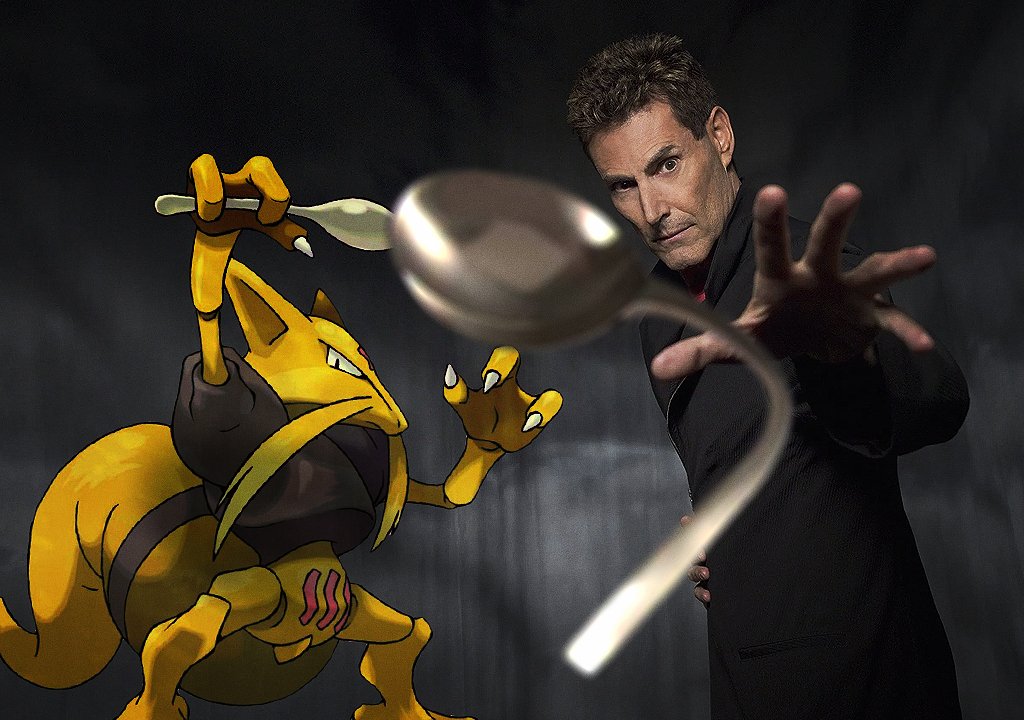Pokémon: the mysterious case of Uri Geller and the missing Kadabra

Uri Geller: a question of spoons
Have you ever heard of Uri Geller? Maybe yes, maybe not: certainly less than Pokémon. And in fact the story that binds him to the monsters of Game Freak is rather strange: it somehow has to do with an uncomfortable legal case. But let's start from the beginning, as it should be: Uri Geller is an illusionist, one of the good ones. Good enough to hold rather well-known shows, to appear on television, to have built an entire professional career around him. You can consider him a very talented magician or magician.The "power" that Uri Geller attributes to his figure is the telekinetic one: he would be able to bend spoons only thanks to the strength of his mind. If that's true or not, well ... who are we to judge or comment on this talent, that is, spoon bending? We limit ourselves to quoting his words, and those of those who have had the opportunity to attend his performances. Exactly twenty years ago, the path of Uri Geller and that of Nintendo met.
They met because Geller too had been struck by the phenomenon of the moment, namely by Pokémon. And he had noticed that one of them - Kadabra - seemed to possess the same powers as him. A matter of spoons, in short: and the illusionist certainly couldn't let it go.
The lawsuit and Pokémon cards
Soon we arrived at a real lawsuit: the that is, Uri Geller's attorney wrote to Nintendo. He said that Kadabra, the Pokémon of the first generation and intermediate evolution between Abra and Alakazam, was created based on the personality of the illusionist, his "gift" and his performances. In short, it represented a violation in all respects: Nintendo could not use that monster without permission. All the more so as Kadabra exploited overt telekinetic powers (like Geller), bent spoons with his mind (just like Geller), and his Japanese name was Yungerer, which looks a bit like it could also have been written as Yungeller (Geller! Geller again! ).The artist threatened to take Nintendo to court and expressed his request, actually curious: to remove Kadabra from the trading card game. Not from video games, only from the collectible card game: go to understand, the artists. In what today appears to everyone as a little personal madness, Nintendo accepted: and since 2003 Kadabra was no longer printed as a collectible card. Maybe you hadn't even noticed it, but things are exactly like this: so much so that, to overcome all subsequent problems for the balance of the game itself, Abra was allowed to evolve directly into Alakazam.
If the revelation seems shocking to you, why not go and retrieve your collection dedicated to Pokémon: Trading Card Game? Maybe you will find lots of Abra, different holographic Alakazam ... but how many Kadabra? Seek, seek.
Repentance: Kadabra is back
This story has a happy ending, as you will soon realize. Instead of ending in tragedy, it ends in repentance. A few days ago, in fact, Uri Geller released a very important communication via the official Twitter channel: "I am really sorry for what I did 20 years ago". And away: 26,000 hearts, nearly 10,000 shares, more than 1,500 comments. All Kadabra fans from all over the world, united, have come back to light after a long stay in the caves of forgetfulness.window.twttr = (function (d, s, id) {var js, fjs = d.getElementsByTagName (s) [0], t = window.twttr || {}; if (d.getElementById (id)) return t; js = d.createElement (s); js.id = id; js.src = "https://platform.twitter.com/widgets.js"; fjs.parentNode.insertBefore (js, fjs); t._e = []; t.ready = function (f) {t._e.push ( f);}; return t;} (document, "script", "twitter-wjs")); twttr.ready (function (twttr) {twttr.widgets.createTweet ('1332794451727691777', document.getElementById ('tw_1332794451727691777'));});
The artist has again granted permission to print Kadabra to Nintendo, which thus becomes the owner of the rights; and the company is obviously no longer threatened (at least for the moment and barring further thoughts) by a new lawsuit. But why this sudden repentance, more than twenty years later?
A quick glance at Uri Geller's comments and Twitter profile provides some insights, but no answers: no one will ever be able to enter his mind ... psychically intense. Some argue that it was a scene to regain some notoriety, especially in the world of the web. At the same time, it doesn't seem like Geller needs it that much, not that of Pokémon fans at least. Did he really feel sorry, all of a sudden, about such an "old" story?
However, due attention must also be given to the chosen words. "Now it's up to Nintendo to get my Kadabra Pokémon card back." Yes, you read "my Kadabra Pokémon card" right. Apparently, the illusionist still thinks that that Pokémon was born taking its cue from its shows. We close with a funny comment found on Twitter: "why, did you perhaps invent spoons?"